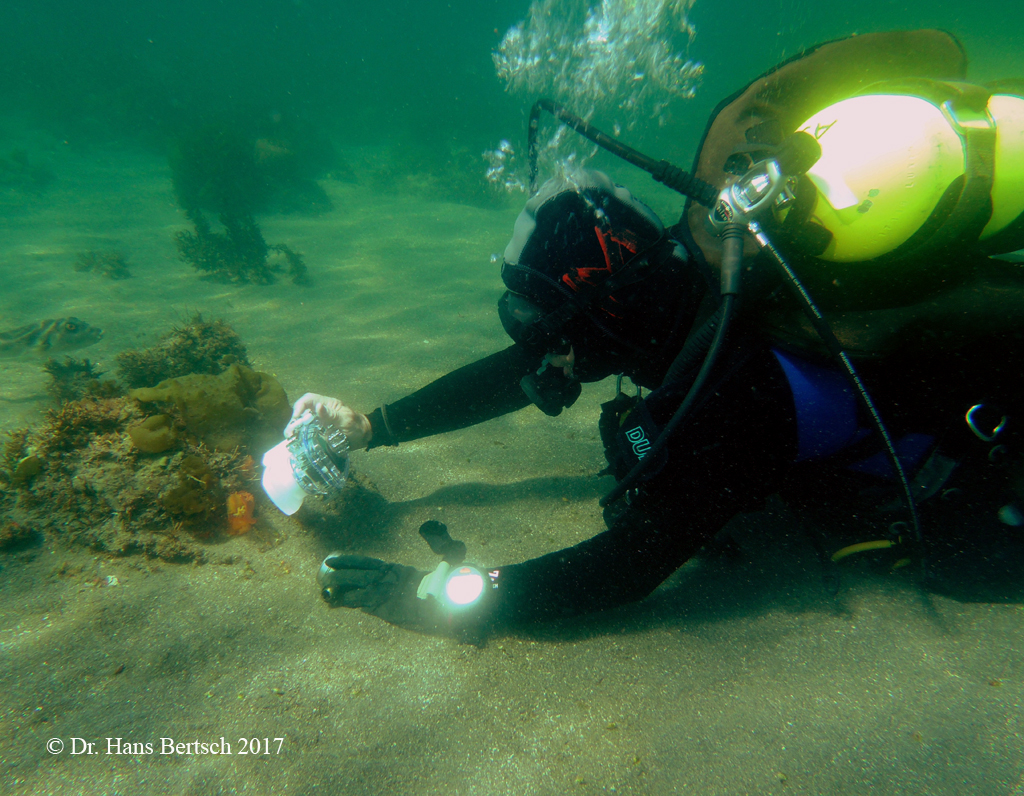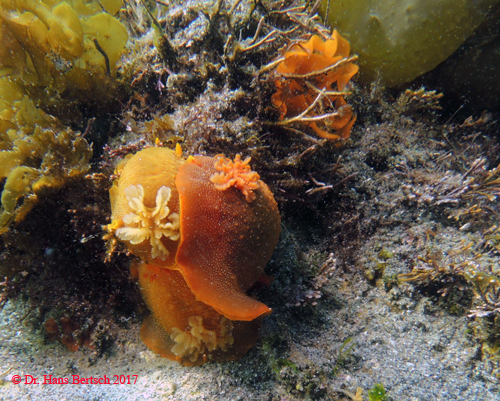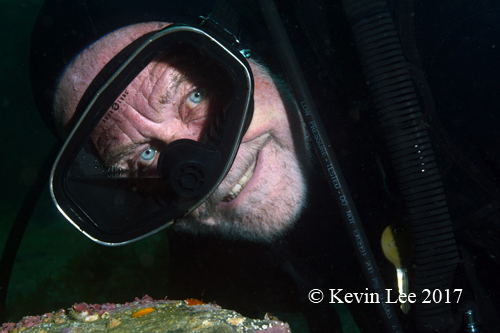 |
Doriopsilla davebehrensi Hoover, Lindsay, Goddard & Valdés, 2015
Mike Miller photographing a copulating trio with their egg mass
(Photo: Hans Bertsch, at Cuevitas, Bahía de los Ángeles, February 2014)
The trio (68, 43 and 52 mm in length), on the pink morph of the sponge
Cliona californiana
 |
BOW Number 1000!!! CONGRATULATIONS, MIKE! This is truly a milestone. On behalf of all nudiphiles around the world, I thank you for your dedication, service, assistance and major contributions to research and conservation in providing The Slug Site for all to use. Your site has been and is a joy to behold. It is a source of invaluable information, contributed to and used by investigators, divers, marine biologists, students and biodiversity enthusiasts globally. It is also appropriate that we show Doriopsilla davebehrensi BOW 923 this week, since Dave Behrens has been a major text writer for numerous BOWs over the decades. Mike asked me to write a few words for BOW 1000, providing some thoughts on future directions of nudibranch research. Although this is not exactly what he wanted, I want to first take the opportunity to give some accolades to our faithful and beloved webmaster. A few tales need to be told. DIVING BLA WITH MIKE MILLER His diving experiences in the Philippines and the other side of the Pacific are his favorites and most repeated. Terry and Dave named the dark malachite-green Nembrotha milleri Gosliner & Behrens, 1997, BOW 62 deservedly in his honor. This tunicate-eating nembrothid was originally collected from Luzon, Cebu and Mindanao in the Philippines, but it is now known more widely from localities throughout the Indo-Pacific. Mike has accompanied me on several expeditions to Bahía de los Ángeles (affectionately abbreviated BLA), in the Gulf of California, looking for and photographing nudibranchs. Luis Aguilar Rosas and I even used his image of Acanthodoris pina Marcus & Marcus, 1967, with its egg mass in our new reference book Invertebrados Marinos del Noroeste de México / Marine Invertebrates of Northwest Mexico. Last century, he and I dove Punta la Gringa in the summertime, and worked there with Sandra Millen . |
The adventures continued. There is a little known joke: “How many Ph.D.s does it take to change a flat tire?” Answer: Only two—if Dr. Tooth (our diving dentist colleague, Dr. Alan Grant) and Mike do the work! As the photo shows, one Ph.D. is taking pictures, while the other Ph.D., Ángel Valdés, surveys the scene. Alan and Mike changed the tire.
Just a few years ago (February 2014), Mike and I drove down the peninsula to dive at BLA. We made the obligatory photo stops on the High Desert, and at the Lookout above the bay. Gorgeous, sunny, warm days, and we had to carefully plan our entries because of the dangerous surf conditions (!!!). Despite our cautions, Mike fell while exiting from the dive at Cuevitas and sliced open his shin. A bloody mess, requiring immediate attention. After stowing our gear in my Jeep, we drove to town for emergency medical care. However, we first stopped at China’s Taco Stand, so Mike could build up his strength and courage with some fried, beer-batter fish tacos. Aayyyy. The clinic was closed, but a note directed us around the corner to the Police Station, where we found Doctora Claudia and assistant . Within minutes, Mike was on the operating table, further anesthetized, stitched up, and recovered for a group portrait, all in under 20 minutes. When Mike asked her what he owed, she responded with a “whatever,” expecting the 50 pesos ($2.50 US) that the residents of this fishing village usually could afford. To her surprise, he gave her 1000 pesos (about $50 US), telling me later, “Cheaper, faster, and as high a quality as I would have gotten from my plan at a US emergency room!”
WSM—ENTERTAINING MEETINGS AND TALKS
Mike has showcased his spectacular underwater videos of minuscule crawling, eating and copulating nudibranchs at several international meetings. Back in 2012, the International Workshop on Opisthobranchs was held jointly with the annual meeting of the Western Society of Malacologists in Santa Cruz, CA. The t-shirt featured the land shell-less Heterobranchs. Search the group photo for Mike, Terry and Ángel, Jeff Goddard, Gary McDonald, Kevin Lee, Chris Kitting, Craig Hoover, Sandra, Martha Reguero, Jazmin Ortigosa, Jesús Troncoso and others.
MOLLUSCA 2014 was a tri-society meeting (Western Society of Malacologists, American Malacological Society, and Sociedad Mexican de Malacología), held in Mexico City. The pictures show Mike, Sandra and Terry figuring out how to configure the computers for their presentations, and Mike answering questions, proudly wearing his best attire—the Geezer Diver t-shirt!
BEYOND 1000
Well, enough tales and pictures. I should probably write what Mike asked me to write if I have any hope that he’ll post this.
In the past 10 years or so, nudibranch taxonomy and phylogeny has been significantly advanced by numerous DNA studies. These are continuing, and combined with morphological, biogeographic and natural history data will continue to provide us with marvelous new understandings of the evolutionary relationships among the many taxa of Heterobranchia. In addition, here are some ideas, perhaps even a bucket list!
1. There seems to be a backlog of unnamed species. For example, two weeks ago, Dave wrote that BOW 998 was one of 46 undescribed species of Goniobranchus that he is aware of. This is not an isolated example. It should be a priority to name these known-but-unnamed animals, even if based on only a single or few specimens. The naming of an animal often results in additional findings and information about its biology. Besides the “search engine” quality of a Linnean nomenclature is quite remarkable.
2. Long term ecological studies are needed. Laboratory work must be based on extensive field work. The animals have evolved in dynamic underwater ecosystems that must be understood. Professors with many students can initiate ongoing research projects of several species or selected sites that over the years would yield data useful for effects by climate change, anthropogenic activities, or natural variations. Decades-long data bases, such as Jim Lance’s for La Jolla and mine for BLA, provide marine records for top-of-the-chain carnivores, including changes throughout all trophic levels of the ecosystems.
3. Why not have an “Annual Nudibranch Count”? Similar to those for butterflies in the United Kingdom and birds throughout the United States, they involve trained citizen scientists, and have resulted in multiple papers on biodiversity loss or change across multiple latitudes and longitudes. For example, in southern and central California there is a dedicated cadre of scuba divers who actively look for and photograph nudibranchs. Their notes and images could easily be combined into a multivariate data set.
4. I confess to watching lots of crime shows on TV, and every program involves a make-believe technical wizard like Abby Sciuto (NCIS) or Penelope Garcia (Criminal Minds), using a “facial recognition” program to identify the sought-after crook. Well, why not? A “facial recognition” app or program for nudibranchs! A minimum of two views, dorsal and lateral, in the system would be sufficient for a quick, reasonably reliable field identification. Those species with a variable morphology would have multiple images. Surely a search machine or camera company (like Google or Nikon) willing to fund such a program could be found.
5. To carry this one step further, a handheld, underwater DNA tester, to retail for less than $50 US. The apparatus would take a quick sample of fluid, process it, and spew out the DNA bar code species’ identification. Again, why not? It’s just a matter of waterproofing, and miniaturization of technologies currently available (see, Elizabeth Pennisi, “Genome sequencing in the hand and bush,” Science 354: 1522, 23 Dec. 2016, which explains the process of nanopore sequencing).
So there you have it: a challenge for us to keep looking, keep observing, and keep recording, to understand, appreciate and conserve the endangered beauty and biodiversity of life in our oceans.
Mike, thank you! We look forward to the next 1000.....
Imperial Beach, Calif
Feb., 2017
Send Hans email at hansmarvida@sbcglobal.net

|
Photo courtesy of Kevin Lee
WEBMASTER'S NOTES:
Since neither the site or myself will probably not be around for the second 1000 milestone, I wish to take the opportunity at this time to thanks Hans, Dave and all the contributors through the years that have made this site possible, a real work in progress!
The genesis of the site goes back to 1994 at a California Association of Criminalists meeting that I attended while employed with the Naval Investigative Service (NIS) as a forensic chemist (more on this later). I happened by a poster exhibit that featured a new technology-world wise communications via the Ethernet! The lady manning the booth has a particular interest in dogs so she took us to a site in Spain where one could browse information on the particular breed of dog the lady had! Well, needless to say I was bowled over by this "peek into the future." At that time many higher institutions of learning were communicating via the INTRANET where access was generally limited outside the institution.
In 1995 all this changed with the evolution of the INTRANET to the INTERNET which enabled access to everyone. I love dogs but the immediate focus of my interest was on sea slugs! Having taken an early retirement from NIS in 1995, I was in a position to explore setting up a "website" devoted exclusively to our sea slug friends. The first site Internet Service Provider (ISP) was called the Electric Company and was staffed by what looked to me, a bunch of teenagers (later to become known as Geeks)! The manager who signed me up just turned 22. Anyhow, I got 5 megs of space and was off and running! Electric Company is no longer around, probably bought out by a larger Tel Com company. The original staff probably went on a prolonged vacation with their new found wealth followed by going to work for a company like Goggle as program directors!
Getting back to my service with the Naval Investigative Service (NIS) which later became the Naval Criminal Investigative Service (NCIS)! A few years after I retired in 1995, the Navy closed the remaining two labs in San Diego and Norfolk! Before the closing at the San Diego lab, the original cast of NCIS did a tour of the lab and my chemist partner Bob Blackledge was able to take pictures of that event. There was an inkling of what was in store entertainment wise with the advent if the first forensic show CSI Las Vegas which immediately took off. Nobody but nobody had any premonition the same would hold true for a Navy version. If we had, we all probably would have sharpened our script writing skills or taken acting lessons. Yeh, I know, I for one certainly don't have the acting talent or sex appeal of Abby Sciuto, who plays the forensic wizard on NCIS!
Thanks again contributors and readers!
San Diego, Calif
Feb. 2017
